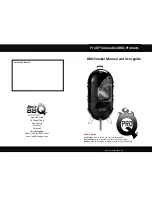
Issue
2
1
947833
CAUTION: To reduce the risk of electric shock,
Do not remove cover.
No user serviceable parts inside.
Refer servicing to qualified service personnel.
CAUTION
RISK OF ELECTRIC SHOCK
DO NOT OPEN
This symbol indicates that dangerous
voltage constituting a risk of electric
shock is present within this unit.
This symbol indicates that there are
important operating and maintenance
instructions in the literature accompanying
this unit.
VIP-426A-D
IP FLUSH MOUNT SPEAKER/CLOCK
INTRODUCTION
The VIP-426A-D IP Wall Speaker with Clock enables
voice access and visual time indication to a single zone of
paging over an IP-based LAN/WAN. This allows page
zone extension anywhere on the network. The speaker
level is adjusted via software during set up. Clock
synchronization is initiated via connection to any Network
Time Protocol (NTP) server accessible via the network.
The enclosure is made of steel with a durable powder
coated finish. The color of the enclosure can easily be
changed to match any décor. Power is provided to the
VIP-426A-D via a Power over Ethernet (PoE) switch
meeting the 802.3af specification.
SPECIFICATIONS
Access Methods
• PBX, FXO Port using a VIP-811
• POTS telephone set using a VIP-811
• PBX, FXS Port using a VIP-821
• Valcom M Cast Page Group
• SIP–enabled telephone system
Features
RJ-45
network
connection
802.3af
compatible
Network Time Protocol (NTP) synchronization
Six digit time display
DIMENSIONS/WEIGHT
14.50” H x 13.00” W x 3.40” D
(36.93cm x 33.02cm W x 8.64cm D)
Weight: 4.8 LBS (2.17 kg)
Environment
Temperature:
0 to +40° C
Humidity:
0 to 85% non-precipitating
Nominal Power Requirements
Via 802.3af PoE Ethernet Switch:
Class 3
Precautionary Designations
INSTALLATION
FCC Information
This equipment has been tested and found to
comply with the limits for a Class A digital
device, pursuant to Part 15 of the FCC Rules.
These limits are designed to provide reasonable
protection against harmful interference when
the equipment is operated in a commercial
environment. This equipment generates, uses
and can radiate radio frequency energy and if
not installed and used in accordance with the
instruction manual, may cause harmful
interference to radio communications.
Operation of this equipment in a residential area
may cause harmful interference in which case
the user will be required to correct the
interference at his own expense
.






















